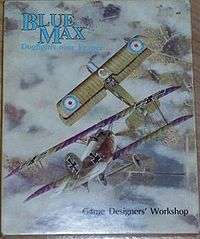Blue Max (board game)

Blue Max is a multi-player board game of World War I aerial combat over the Western Front during 1917 and 1918. Each player is a fighter pilot of the British, French, American, or German air service. Each game is a single dogfight, in which players try to shoot down as many enemy planes as possible without being shot down themselves. There is no limit to the number of players in a single game. It was first published by Game Designers Workshop (GDW), in 1983. The game is named after the prestigious German order Pour le Mérite, informally known as Blue Max.
History
Blue Max was designed by Phil Hall and originally released in 1983. A reprint of the boxed version was released in 1992. An updated miniatures version was released in 1995 that included early war aircraft designed by Alan Wright. The miniatures version did not include the aircraft counters or map of the boxed versions. Blue Max was selected as one of the best one hundred games by Games Magazine in 1993 and won the GAMA award for graphics in the same year. Canvas Eagles, an upgraded version of Blue Max, was designed by Eric Hotz and released free on the web.
Mechanics
The game is played on an hexagonal board, using a maneuver chart from which, every turn, you decide which move your plane will do. After every player has decided their move, all the planes are moved simultaneously on the map. You can fire at another plane only if it is directly in front of your plane and at a maximum distance of 3 hexes.
The rules are simple and most of them are contained in the components used during play; reference to the rule manual is rarely necessary. After playing some games, you can start to use the campaign rules which add another level of fun and challenge to the game.
Third edition
The last edition of the game, the third one, has been published by Giochi Uniti and Stratelibri on February 2014.[1]
Translations
The game was at least translated into French (Les Ailes de la gloire, Oriflam, 1992) and into Spanish (Blue Max, Diseños Orbitales, 1992).
References
External links
- Blue Max and Canvas Eagles at BoardGameGeek
- You Play It - you can play this game online for free at www.YouPlay.It.
- Eagles-Max - Download the rules and start playing!